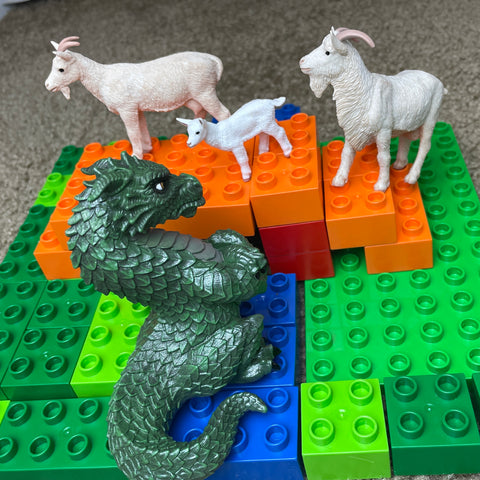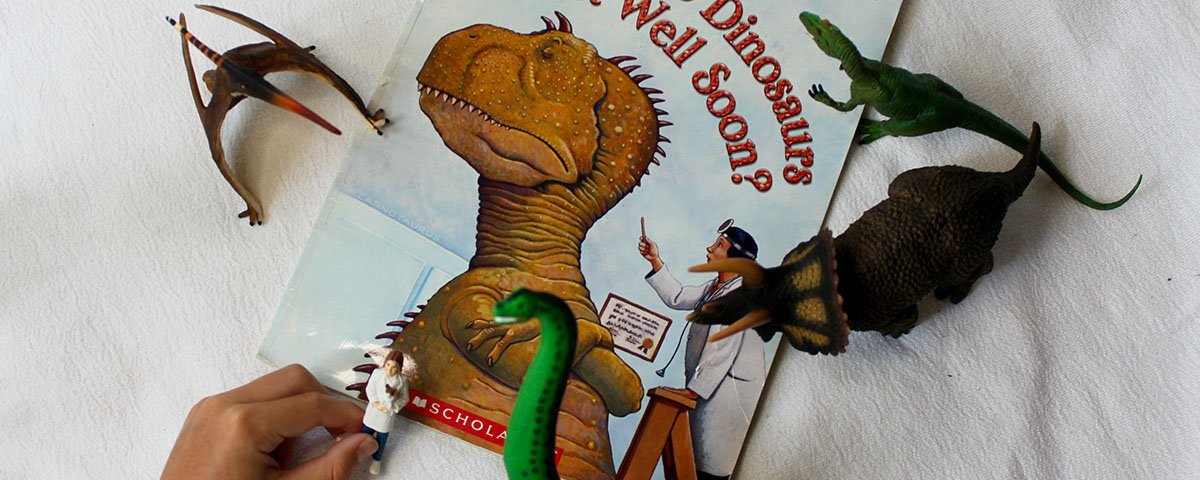How can we help our kids make gains in literacy skills, and more importantly, love to read and write? Play, play, and more play...injecting play and hands-on elements into literacy activities is sure to up engagement and enchant little reluctant learners.
“Through creative play, your child will develop a multitude of critical skills for reading comprehension including prediction skills, critical thinking skills, cause and effect relationships, sequencing, identifying character motivations, identifying multiple perspectives, identifying conflict in the plot of the story and its resolution, creating alternate endings, and answering open-ended questions.” - chonline.org
Full article on building critical reading comprehension through play here.
Boost your child’s writing with Safari Ltd. toys!

Story Starters with Good Luck Minis and Safari Ltd. TOOBS
Place an assortment of Good Luck Minis, TOOB characters, and landmark figurines from the Safari Ltd. Around the World TOOB in separate containers. Have your child choose a toy from both containers. Their story will then include the chosen toys. For example, they may pick a Good Luck Mini dragon and the Pyramids in Egypt, and so their story would be about a dragon in Egypt. They can choose additional characters or landmarks to jumpstart more ideas.
Creative Partner Stories with Safari Ltd. TOOBS
This is an absolute favorite activity in my classrooms and in my own home! Using the Safari Ltd. TOOBS, partners or group members take turns choosing figures from the TOOB and then work the chosen figure into a shared story. The first person closes their eyes and picks a figure from the TOOB and then begins a story based on that figure. The next person then chooses a figure and works that character/object into the story.
For example, if we used the Pirates TOOB, a child might pick out the ship. They could possibly start the story out as “Once there was a haunted pirate ship…” The next person would close their eyes and pick something else from the TOOB. Whatever item they chose would be added into the story. This can be done out loud, written down, or a combination of both. To add even more fun, mix different Safari LTD. TOOBS together to get a funny mix of crazy story elements.
Nature Journal

Nature Journaling is a wonderful way to get kids outside and writing! They can take along a journal and Safariology exploration tools to write/draw about their findings. There are so many interesting things to see in nature to jump start creativity.
Safari Ltd. has many products that will help your child explore and discover natural objects to write about:
Translucent Optic One Exploring Tool
More resources for more information on Nature Journaling with children:
Reading, Phonics, and Phonemic Awareness
Phonics
Safari Ltd. smaller figurines have been used in countless classrooms as language objects to enhance phonics lessons. They can be used for sound matching, spelling practice, sound sorting, etc.
Have your child choose a Safari Ltd figurine from an assortment of Good Luck Minis or Safari Ltd. TOOBS to then say, write, or match (to a letter block, magnetic letter, or letter card) to the appropriate sound for the chosen figurine. Depending on your child’s need, focus on either the beginning, end, or the vowel sound that is heard in the word. For example, if your child pulls out a dog figure, /d/ would be the beginning sound, /g/ would be the ending sound, and /o/ would be the vowel sound. For older children, lay out the figurines and assist your child with spelling the words that represent the figurine. You can pre-write or lay out some of the letters (sounds that may be tricky for your child) for the words and let your child fill in the rest.
Additional spelling tools found at Safari Ltd.:
Rhyming
I always suggest beginning to learn about rhyme through repetitive reading of nursery rhymes and other rhyming books. Children will enjoy learning to anticipate the rhyming words. After many exposures to rhyming language, you can begin introducing rhyming activities to practice the skill.
Pull out a Good Luck Mini figure or an animal from Safari Ltd. TOOBS and have your child say what the name of the figure is. Guide your child in generating as many words as they can that rhyme with the figure name. They can simply say their rhyme list, write it, or draw pictures. For example, if they pull out a cat figure, they could potentially list: hat, mat, sat, bat, rat, splat, etc. It's even more helpful to have additional figures that rhyme with each other or printed pictures that rhyme with a figure.
For older kids, instead of simply listing the rhyming words, focus on the spelling chunks (the rime) that they hear/see at the end of rhyming words. For example, if they know cat is spelled with the –at chunk (rime) at the end, they can use that knowledge to spell other words that rhyme with cat. This is spelling through word analogy. Educators often refer to a group of words with the same ending as “word families.”
Resource for teaching “word families”:
Syllables

Learning about syllables can be tricky for some kids. There are a couple of helpful ways to teach the concept of syllables. One way is to refer to syllables as beats in a word. Guide your child in clapping or tapping how many beats they hear when they say a word. Another way to help children with syllables is to relate the number of syllables to how many times their chin “drops down” when saying a word. You can have them look in a mirror while saying a word or they can put their hand on their chin while saying the word to count how many times their chin moves down. Try it, say “octopus” slowly, and you’ll notice that your chin slightly drops down 3 times.
Pull out a Good Luck Mini figures or toys from Safari Ltd. TOOBS and have your child say what the name of the figure is. Encourage your child to say the figure name again and then count the number of syllables. When they understand how to find the number of syllables in a word, you can have them sort the Good Luck Minis or TOOB Figures into piles or columns based on the number of syllables.
For older kids, challenge them to spell more difficult figure names by teaching them to use syllables. Helpful tips: each syllable contains a vowel and there are six main (seven depending on resource) types of syllables. Teaching your child how to recognize syllable types and how to “break” a word apart will help them with spelling and reading larger words.
Here are helpful resources for teaching kids how to use syllable types for spelling and reading:
Reading Comprehension
Making Connections
When children have truly enjoyed and engaged with a book, they have taken an adventure to a new world, met new characters, and had new experiences. In addition, books light up a child’s mind with all types of connections. They are reminded of their own experiences, other books they’ve read (or listened to), and things they’ve seen. Making connections while reading is one of the deepest ways of comprehending. Safari Ltd.’s open-ended toys allow for imaginative play which can help promote connections and build comprehension skills.

Use Safari Ltd. minis to see how many connections your child can make. I like to use Safari Ltd. Good Luck Minis or TOOB figures for this activity, but any sized figures will do. You play this game by having your child reach into the bag of mixed figures. Encourage your child to really examine the detailed figure. They can then close their eyes and think of everything that the figure reminds them of. While thinking of all of the connections, they can list them out loud, write a list, or draw pictures. The challenge is to make as many connections as possible. Encourage them to think deeply by throwing out prompts if necessary: “has that figure (“character”) been… in a book that you have read, a movie you’ve seen, reminded you of a similar character.” Make this a competitive game by having additional children (or adults) do the activity at the same time to see who can generate the most connections.
Resources to learn more about helping your child make connections while reading:
Rocking A Retelling
“Acting out or retelling a story helps children make that story their own—and truly comprehend it. They gain an understanding of the characters, the structure, and the themes…They will learn that the story unfolds in a certain way…in the process, young children gain a sophisticated understanding of narrative structure.” - What Dramatic Play Does and how to Support Literacy - full article.

Choose your child’s favorite book(s) and list out some of the characters. Look at the huge selection of various sized figurines offered by Safari Ltd. Select figurines that could represent the characters from your child’s favorite book (See list below for ideas). Help your child gather additional supplies for story elements and setting.
Arrange a play invitation with objects suitable for representing the story setting, important story elements, and characters. Encourage your child to set up the story scene(s) and use Safari Ltd. TOOBS or Safari Ltd. Figurines as the characters to “act out” parts of the story. See the list below for some examples of story and Safari Ltd. figurine pairings.
STEM Extensions

Take reading a step further by following up a great story or nonfiction book with Safari Ltd. figurines and STEM activities. For example, after reading nonfiction books about animals in the winter, kids can do follow up activities revolving around the information that they learn (tracks in the snow, hibernation, migration, adaptations, etc.).
Fairytales and classic children's stories contain many learning opportunities. For the Three Little Pigs, children can construct the Pigs' houses and see if they withstand wind from a fan or blow dryer using Safari Ltd. Large White Pig, Safari Ltd. Hampshire Pig, Safari Ltd. Berkshire Pig.
There are many new books that contain ways to incorporate STEM. Using How to Catch a Mermaid, your child could design "traps" to catch their mermaid figurines or plush toys.

Check out our fabulous selection of books HERE.

